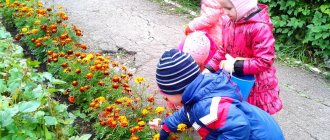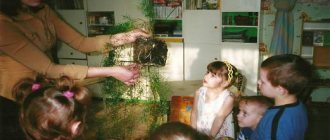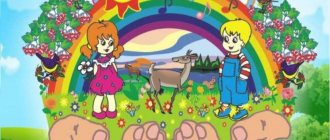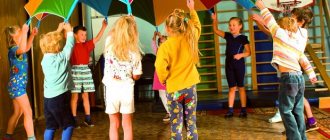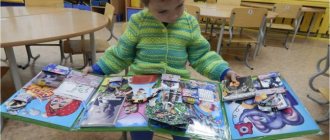Ecological observations and experiments in preschool educational institutions as a means of environmental education of a child
«Ecological observations and experiments in preschool educational institutions as a means of environmental education of a child"
A child's environmental awareness gradually increases if his interest in nature is stimulated. Activities stimulate the child’s feelings and evoke empathy. It is important that the child can appreciate human behavior in nature.
Conducting experiments and organizing experimentation is one of the effective ways to educate preschoolers’ environmental culture. Research activities are of great interest to children. Experiments are like “tricks”. Only the mystery of the tricks remains unsolved, but everything that happens can be explained and understood. Experiments help develop the child’s thinking, logic, and creativity, and clearly show the connections between living and nonliving things in nature. Research provides the child with the opportunity to find answers to the questions “how?” " and why? "
The knowledge gained during experiments is remembered for a long time. It is important that each child conducts his own experiments.
The child should do everything himself, and not be in the role of an observer.
In addition to planned and random experiments, there are experiments that are carried out as an answer to a child's question. Either the child who asked the question or his comrades are involved in conducting such experiments. After listening to the question, the parent does not answer it, but advises the child to establish the truth himself by making a simple observation: “And you yourself see how the ant behaves if its path to the anthill is blocked.” Or: “Let's see if the boat can turn around in a narrow place in the stream.” In the future, if the work is not complicated, it is carried out as a random experiment; if significant preparation is required, it is carried out in accordance with the methodological recommendations described for planned experiments.
Solving experimental problems
With older preschoolers, you can begin to solve experimental problems. Three types of experimental tasks are available for preschoolers:
— How to prove that...(air can move objects, etc.)
- In how many ways can this action be carried out... (put out a candle, transfer water from one jar to another, move an object from the table, etc.)
- Predict what will happen if...(put a needle on the surface of the water, put a coin in a saucer filled with water to the very brim, etc.)
Problem solving is carried out in two options:
1. Children conduct an experiment without knowing its result, and thus acquire new knowledge.
2. Children first predict the outcome and then check whether they thought correctly.
The more varied and intense the search activity, the more new information children receive, the faster and more fully they develop.
"Flames pollute the air."
Light a candle. The flame is burning. Can it pollute the air? Hold a glass or porcelain cup at a distance (1-2 cm) above the candle flame. After some time, you will see that this object has turned black from below - covered with a layer of soot.
"Plants drink water."
Place a bouquet of flowers in colored water. After some time, the stems of the flowers will also color.
Conclusion: plants drink water.
“Sand allows water to pass through well, but clay does not”
Take 2 identical funnels and place them on the glasses.
Place a little cotton wool in each funnel. Fill one funnel halfway with sand, and put crushed clay in the other. Fill both funnels to the top with water. Watch. Sand permeates water well, but clay does not. Sand is a free-flowing substance. Clay consists of small particles strongly bonded together.
"Drown and Eat"
Wash two oranges thoroughly. Place one of them in a bowl of water. He will float. And even if you try very hard, you won’t be able to drown him. Peel the second orange and place it in water. Well? Don't believe your eyes? The orange drowned. How so? Two identical oranges, but one drowns and the other floats? Explain to your child: “There are a lot of air bubbles in an orange peel. They push the orange to the surface. Without the peel, an orange will sink because it is heavier than the water it displaces.”
"Fried Sugar"
Take two pieces of refined sugar. Moisten them with a few drops of water to make it moist, place them in a stainless steel spoon and heat it over gas for a few minutes until the sugar has melted and turned yellow. Don't let it burn. As soon as the sugar turns into a yellowish liquid, pour the contents of the spoon onto the saucer in small drops. Taste your candies with your children. Liked? Then open a confectionery factory!
Educator:
Get text
How schoolchildren fight environmental problems: five inventions
The Ocean Cleanup, unfortunately, is not a project of the future and will not help the ocean in any way.
Rather, it can be compared to Theranos in miniature. There are several reasons for this:
1. Most plastic enters the ocean through rivers. That is, the main problem is on land. And it needs to be solved on land
2. Most of the plastic in the seas and oceans settles to the bottom and decomposes there into micro-plastic. The concept of “plastic islands” is idealized. In fact, we are talking about huge accumulations of semi-decomposed plastic
3. After prolonged interaction with water, plastic becomes unsuitable for recycling. At least for commercial processing.
These are the main reasons why this project has no value. First of all, as a commercial project. And as a result, it cannot claim to be the global solution to the plastic collapse.
It should be added that according to official sources, at least $47 million was spent on this project.
But even on land, unfortunately, only a small part of plastic can be processed mechanically on an industrial scale. After sorting, most polymers are either burned (at best to generate electricity) or buried in landfills. All this happens because the rest of the plastic has no economic value for existing mechanical recycling methods.
It’s surprising why most activists, media and government officials are still silent about the possibilities of chemical recycling of plastic using the pyrolysis method.
Meanwhile, it is this technology that helps answer the question that has been asked from all public platforms for more than a year now - “How to solve the problem of plastic waste?”
And that's why:
Through chemical processing
1) Any type of plastic is now recyclable.
2) Market value is created for previously “useless” waste - that is, plastic is processed into diesel fuel and naphtha (used in many processes in chemical production), as well as coal and CO2 (used, for example, in greenhouses).
3) CO2 emissions are reduced as petroleum products are made from local plastic. There is no need to re-extract and transport oil. The carbon footprint is reduced accordingly.
4) Truly circular systems are being formed that will allow us to use resources more efficiently.
5) Economic indicators will increase and new jobs will appear
6) The problem with the formation of micro-plastic will be solved. During chemical processing, plastic changes into gaseous and liquid states.
You can read more about the situation with plastic in the article:
or https://t.me/ecopirate
Summer experiences and ventures in nature: 13 incredible ideas
Sundial
Setting up an equatorial sundial at your dacha or site is not at all difficult. A gnomon - the future hand of a sundial - can be made from a stick, cardboard or a shovel handle. If you want to do everything exactly according to science and determine not solar time, but Moscow time, the angle of inclination of the gnomon should be equal to the latitude of your area. The dial is divided into 24 parts. You can very beautifully mark the divisions with shells or lay out numbers from pebbles.
Solar drawings or cyanotype
You need to cover paper or fabric with a special photosensitive solution, then lay out silhouettes cut out of paper, dried blades of grass and flowers, leaves, lace on it, cover with glass and leave for 3-4 minutes in bright sun. On top of the glass you can place small objects (keys, shells), glass marbles. And then rinse with water. A chemical reaction occurs, and white silhouettes and outlines of blades of grass remain on a beautiful blue background. To prepare the solution, you need ammonium ferrocitrate (III) - (25 g per 100 ml of distilled water) and red (blood) salt - potassium ferrocyanide - (10 g per 100 ml of distilled water). The solution is made one time at a time and applied to paper under red light. Ready-made kits for cyanotype are sold in photo stores.
By the way, if the sun is a frequent visitor to the balcony, you can place any objects on a sheet of ordinary colored or tinted paper and place them in a sunny place. The paper will fade, but the silhouettes of the objects will remain.
Solar tattoo
For older children who love to sunbathe, or for dad who sleeps soundly, you can create a sunny surprise. Stick an image of a butterfly or flower on your arm or back (the outline can be cut out inside) or tie a stencil bandage with an image cut out inside. A white image will appear against the background of tanned skin.
Tame the Rainbow
You can see a homemade rainbow by using a hose or flower sprayer in sunny weather. And an experiment with seven glasses, citric acid and soda will help you play rainbow. Learn the treasured rhyme about pheasant hunting with your child, pour paint or food coloring of the appropriate color into each glass, then add soda and citric acid, add water. The rainbow river is ready. It’s very cool to conduct the experiment on A3 size watercolor paper; you’ll get a beautiful background for the painting.
Sand Volcano
The experiment with soda and vinegar, beloved by many, can be improved by making a volcano not from plasticine, but from sand, placing a plastic container inside. An option for older children is to dig a real volcano out of damp sand, put dry grass inside and set it on fire. Real smoke is pouring out, the delight of the children is guaranteed.
Magnifier and burning
Try to slightly modify the bitter experience of the inquisitive Emil from Lenneberga and use a magnifying glass and a sunbeam to burn out not a hole in a hat, but a beautiful pattern on a wooden tablet as a gift for your grandmother.
Bubble Snakes
Put an old sock on a bottle with the bottom cut off and secure it with an elastic band. Pour some water and dish soap into a bowl and blow into the neck of the bottle. A garland of soap foam appears, resembling a snake or a beard.
catch the wind
To “catch” the wind, you can make a comet ball out of fabric by sewing a tail made of felt or corrugated paper onto it. Or you can make a net from a wire ring and T-shirt bags and, tying it to a stick, run down the hill with it with a wild whoop or watch the direction of the wind. Or ask the wind to play on old forks and spoons, painted with acrylic and hung on an apple tree. Wind chimes can also be made from small-diameter flower pots, beads, ribbons and bells.
Two-stage balloon rocket
Even a six-year-old child can make such a rocket. The bottom of a plastic cup needs to be cut off. Inflate a long balloon and put it in a cup, and then place an inflated small round balloon underneath. Untie the string from the little ball and the rocket will take off!
Water rocket "Daddy can"
In this case, you cannot do without your dad or grandfather. It is better to launch a rocket in an open field. The rocket requires a 1.5-liter bottle, a bicycle nipple, a wine bottle pump and cap, or a sports dispenser from a plastic bottle. The nipple is installed in the plug; to ensure a tight seal, you can coat the parts with superglue. The launch pad acts as a stand to hold the bottle in a vertical position. When starting, one adult holds the bottle, the other pumps. The cork flies out, the rocket soars into the air to a height of 6-9 floors! Warn children to stand back during launch and never lean over the rocket.
Soda machine
Surely, in any child’s household there will be a lower part of a car with wheels. Many people's favorite mentos + soda experience will turn unwanted debris into a jet machine if you attach a bottle to the platform and throw the mentos inside when it is in an upright position. When the reaction begins, plug the neck of the bottle with your finger and put the car on wheels. She will go, leaving a sweet fountain behind her.
Soil erosion experiment
To clearly show children how important plants are and the dangers of soil erosion, take three bottles cut in half. In one, sow seeds or place soil with growing grass, in another - pour soil with leaves, in the third - sand. Hang an inverted bottle neck or bottom on a string to the neck. When watering the soil, the water in the bottle will flow out, and the child will see how the roots of plants protect the soil from destruction and the water from pollution.
Plumbing maze
Setting up a real labyrinth for water from pipes, ladles and old pots is not at all difficult. A fence, an old door or a wooden panel will be suitable for the base. Nails or screws, ropes cut along the bottle, old hoses and your imagination will be used. Children can pour water and come up with new combinations for the water maze endlessly.
Progress of the experiment:
Let's pour water into the container - it's a river. Then add oil to form a clearly visible film - “oil from a tanker”
What happens if you cover an aquarium with fish with plastic wrap? (the fish will die, because the film does not allow air to pass through and the fish cannot breathe. So the oil film does not allow air to pass through, fish and other inhabitants of water bodies die.
Let's purify the water without mixing it through a straw (let the children try to pour the oil over the edge, scoop it out with a spoon)
.
Remove the clothespin from the tube and pour the water into a placed jar; when an oily layer appears, clamp the tube with the clothespin. As a result, there will be clean water in the jar, and the oil will remain in the container.
Is it possible to drain the river too? How many people and time does it take to purify water? Will fish be able to survive all this time without air?
Conclusion. An oil spill poses a serious threat to wildlife.
"Birds and Oil"
The purpose of the experiment : to help children understand how oil pollution of water bodies affects waterfowl.
Material: downy bird feathers, any liquid oil (vegetable)
